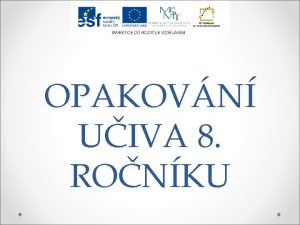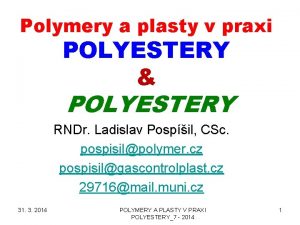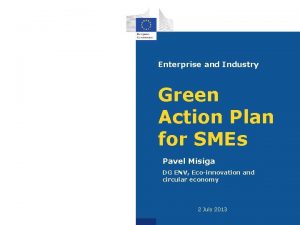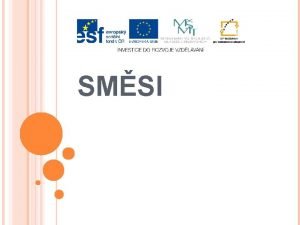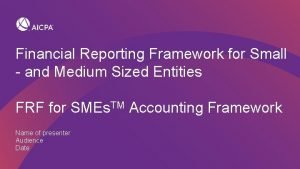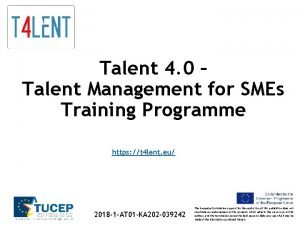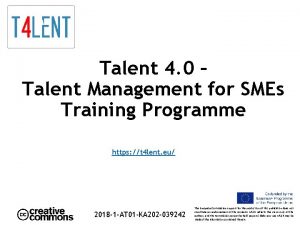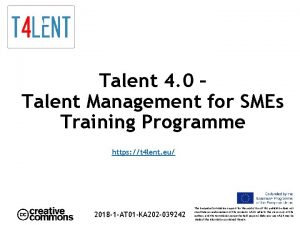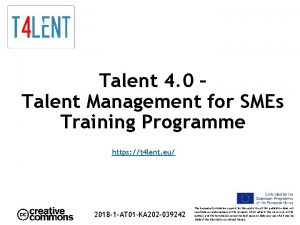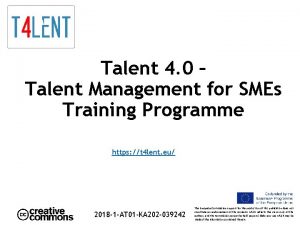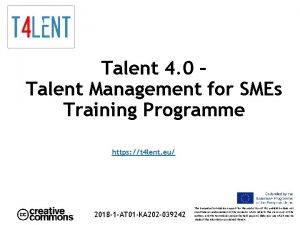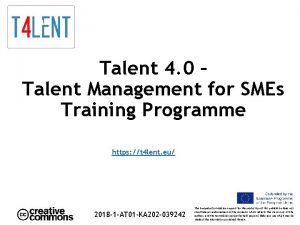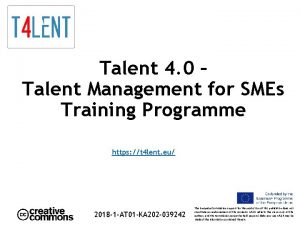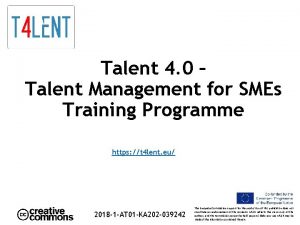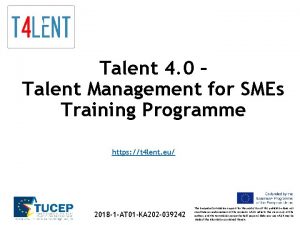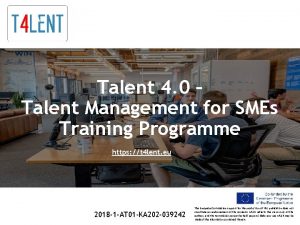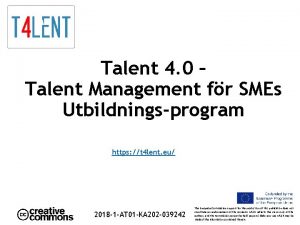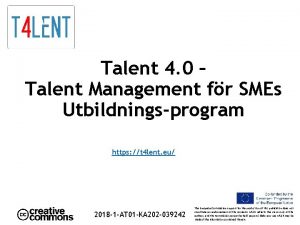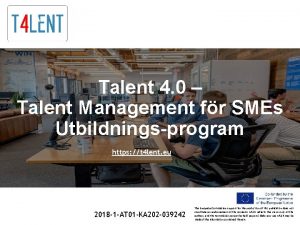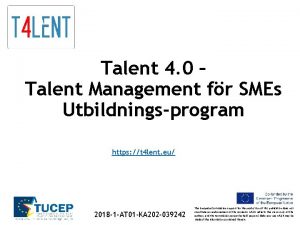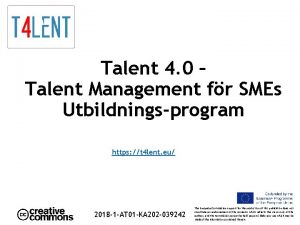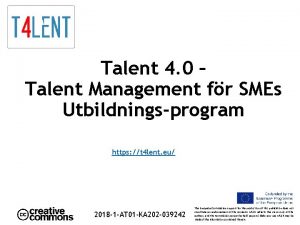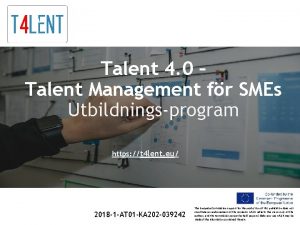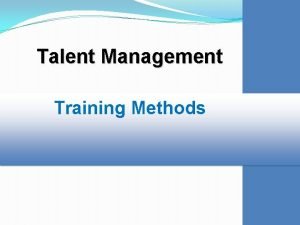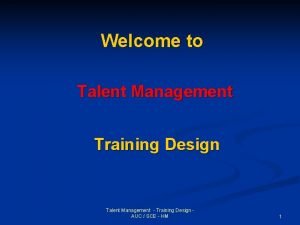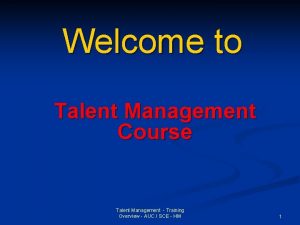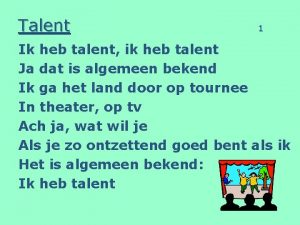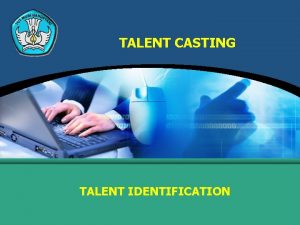Talent 4 0 Talent Management for SMEs Training






























- Slides: 30

Talent 4. 0 – Talent Management for SMEs Training Programme https: //t 4 lent. eu/ 2018 -1 -AT 01 -KA 202 -039242 The European Commission support for the production of this publication does not constitute an endorsement of the contents which reflects the views only of the authors, and the Commission cannot be held responsi blefor any use which may be made of the information contained therein.

M 5: How to retain your Employees Unit 1: Strong Organizational Culture Prepared by ie. Team, Spain 2018 -1 -AT 01 -KA 202 -039242 The European Commission support for the production of this publication does not constitute an endorsement of the contents which reflects the views only of the authors, and the Commission cannot be held responsi blefor any use which may be made of the information contained therein.

Learning Outcomes This module is intended to help and guide learners to understand: 1. The importance of a strong organizational culture in the company. 2. The relevance of the relationship between the work environment and talent retention. The objective of this module is to become more aware about the importance of organizational culture and occupational welfare, and their impact on workers. 2018 -1 -AT 01 -KA 202 -039242 The European Commission support for the production of this publication does not constitute an endorsement of the contents which reflects the views only of the authors, and the Commission cannot be held responsi blefor any use which may be made of the information contained therein.

Introduction What are the aligned values, beliefs, behaviour and experiences that make up the organization's environment? Why is culture fit so important for retaining great talent? For answering these questions, the first thing that must be done is to define what a good organizational culture is and, above all, to clarify the steps that need to be taken to develop it. 2018 -1 -AT 01 -KA 202 -039242 The European Commission support for the production of this publication does not constitute an endorsement of the contents which reflects the views only of the authors, and the Commission cannot be held responsi blefor any use which may be made of the information contained therein.

Defining Organizational Culture Organizational culture constitutes the personality and identity of each group and each organization which allows them to differentiate themselves How? In order for employees to feel committed to companies, it is essential that an organizational culture exists or is created that has a set of shared values between all members of the organization. In fact, having an accepted and established organizational culture has a great impact on employee satisfaction and, therefore, on employee loyalty. 2018 -1 -AT 01 -KA 202 -039242 The European Commission support for the production of this publication does not constitute an endorsement of the contents which reflects the views only of the authors, and the Commission cannot be held responsi blefor any use which may be made of the information contained therein.

Defining Organizational Culture Organisational Culture are the patterns of beliefs, values and learned ways of coping with experiences that have developed during the course of an organisation’s history, and which tend to be manifested in its material arrangements and in behaviour of its members. 2018 -1 -AT 01 -KA 202 -039242 The European Commission support for the production of this publication does not constitute an endorsement of the contents which reflects the views only of the authors, and the Commission cannot be held responsi blefor any use which may be made of the information contained therein.

Defining Organizational Culture Studies showed that when employees are in an environment with a welldefined organizational culture, resignations are reduced by 50%. However, when an organizational culture is weak or toxic, employee values are not aligned with those of the company and issues such as lack of loyalty and commitment arise, which consequently lead to employees choosing to leave the company. What can we do to prevent this from happening? 2018 -1 -AT 01 -KA 202 -039242 The European Commission support for the production of this publication does not constitute an endorsement of the contents which reflects the views only of the authors, and the Commission cannot be held responsi blefor any use which may be made of the information contained therein.

Organizational characteristics that promote talent retention 1. Clear Mission 2. Shared and vision corporate values 6. Inclusion 3. Trust 7. Recognition 4. Managerial style and leadership 8. Flat organisational culture 2018 -1 -AT 01 -KA 202 -039242 5. Fairness 9. Empowerment The European Commission support for the production of this publication does not constitute an endorsement of the contents which reflects the views only of the authors, and the Commission cannot be held responsi blefor any use which may be made of the information contained therein.

Organizational characteristics that promote talent retention 1. Clear corporate mission and vision Employees need to feel involved with the mission of the company and feel inspired by it, for that reason the mission of a company cannot be general statements about saving the world. Employees need to consider mission and vision as something challenging, but possible to achieve in order to connect with them and feel engaged (Macey et al. , 2009). 2. Shared corporate values The corporate values guide employees’ behaviour through organisational culture because they give employees expectations of what to do and how to behave in different situations. 2018 -1 -AT 01 -KA 202 -039242 The European Commission support for the production of this publication does not constitute an endorsement of the contents which reflects the views only of the authors, and the Commission cannot be held responsi blefor any use which may be made of the information contained therein.

Organizational characteristics that promote talent retention 3. Trust is about how positively people feel others will act for them and with them in the future”. Dirks (2006) said that when you trust someone you believe that you can count on him/her to do what is right for you. These two aspects of trust are crucial for employees because they ensure security and confidence in the workplace and this encourages innovation. 4. Managerial style and leadership Managers have to be competent with an upward influence. Some of the skills that make a manager competent are problem-solving skills, social judgement skills, knowledge and expertise and style. Leadership plays a very important role. 2018 -1 -AT 01 -KA 202 -039242 The European Commission support for the production of this publication does not constitute an endorsement of the contents which reflects the views only of the authors, and the Commission cannot be held responsi blefor any use which may be made of the information contained therein.

Organizational characteristics that promote talent retention 5. Fairness with tangible rewards such as money or promotion opportunities; fairness with decision making procedures, for example if the decisions are consistent, predictable and uniform; and, interpersonal fairness that refers to the relationship between managers and employees, if there is courtesy, support or kindness in the interactions. Fairness is something really subjective, so it is important to consider that it can be biased by equity comparisons, judgements based on what a person needs or equality judgments. Transparency is also another key factor for engagement, particularly important is the communication within the company. Good internal communication channels help employees to give their voice upwards and maintain them well-informed about the situation the organisation is facing. 2018 -1 -AT 01 -KA 202 -039242 The European Commission support for the production of this publication does not constitute an endorsement of the contents which reflects the views only of the authors, and the Commission cannot be held responsi blefor any use which may be made of the information contained therein.

: Organizational characteristics that promotes talent retention 6. Inclusion Organisations have to engage employees in the process of change, making them feel involved and informing them of the decisions and changes. In this way, employees have the opportunity to express their own thoughts and feelings, in other words, they feel part of the organisation and of the change. 7. Recognition When employees feel recognised and valued by their immediate supervisor or manager, they feel more engaged with their organisation. In addition, they feel that this manager or supervisor is committed, and this also promotes engagement. 2018 -1 -AT 01 -KA 202 -039242 The European Commission support for the production of this publication does not constitute an endorsement of the contents which reflects the views only of the authors, and the Commission cannot be held responsi blefor any use which may be made of the information contained therein.

: Organizational characteristics that promotes talent retention 8. Flat organisational culture Hierarchical organisational structures do not encourage engagement because employees do not feel an important part of the organisation, they feel they are just resources. Therefore, the organisational structure must be designed to be flat, and in this way employees will feel more involved and committed with the organisational achievements and purposes. 9. Empowerment is possible if the organisational structure is flat and the employees have the possibility to take action to response to the situation the organisation is facing. This makes employees feel that they are contributing to the company’s success. 2018 -1 -AT 01 -KA 202 -039242 The European Commission support for the production of this publication does not constitute an endorsement of the contents which reflects the views only of the authors, and the Commission cannot be held responsi blefor any use which may be made of the information contained therein.

Organizational characteristics that promote talent retention …and what about MONEY? Money is not an element that enhances engagement; some researchers consider it as the worst motivator. According to Maslow, once that need is fulfilled you move to the next level for motivation. That means, that if the salary is good for affording basic needs and extra senses, they will look for an organisation that treats them well 2018 -1 -AT 01 -KA 202 -039242 The European Commission support for the production of this publication does not constitute an endorsement of the contents which reflects the views only of the authors, and the Commission cannot be held responsi blefor any use which may be made of the information contained therein.

How can we develop a strong organizational culture? An employee journey map is a visualization of the timeline of the entire employee experience, starting when people consider applying for a position until they leave the company. It depicts all the key touchpoints along the way, while underscoring employee needs and pain points. 2018 -1 -AT 01 -KA 202 -039242 The European Commission support for the production of this publication does not constitute an endorsement of the contents which reflects the views only of the authors, and the Commission cannot be held responsi blefor any use which may be made of the information contained therein.

How can we develop a strong organizational culture? 2018 -1 -AT 01 -KA 202 -039242 The European Commission support for the production of this publication does not constitute an endorsement of the contents which reflects the views only of the authors, and the Commission cannot be held responsi blefor any use which may be made of the information contained therein.

How can we develop a strong organizational culture? 1. Segment your employees 2. Establish the journey for each persona 3. Map feedback and insights to the employee journey 4. Align your measureme nts at different stages in the employee journey 2018 -1 -AT 01 -KA 202 -039242 5. Use automation to manage feedback at scale 6. Combine the employee journey with your engagement survey The European Commission support for the production of this publication does not constitute an endorsement of the contents which reflects the views only of the authors, and the Commission cannot be held responsi blefor any use which may be made of the information contained therein.

How can we develop a strong organizational culture? 1. Segment your employees Throughout the organization, you’re likely to have plenty of different employee personas, and their interactions with the company will be very different. So start by identifying your employee segments. Ideally it should be based on their interactions with the company - for example, an engineer is likely to have a very different experience from someone in your marketing team — rather than demographics like age and gender (these should be split, you look at in the data later rather than as a guiding principle for your personas, as within those demographics there will be plenty of variance in the experience). 2. Establish the journey for each persona Now you know your personas, you can start to map out the interactions they have with the organization from their first contact (usually before they’re hired) all the way through to them eventually leaving. You’ll need to bring in a cross-functional team to input on this, as different teams and departments are likely to have different interactions along the way. You may even want to consider looking at the interactions post-exit as in some cases retirees or past employees may come back or have an interaction with the organization later on, or act as advocates for the organization. 2018 -1 -AT 01 -KA 202 -039242 The European Commission support for the production of this publication does not constitute an endorsement of the contents which reflects the views only of the authors, and the Commission cannot be held responsi blefor any use which may be made of the information contained therein.

How can we develop a strong organizational culture? 3. Map feedback and insights to the employee journey To truly understand the impact of each interaction on the employee experience, you need to be able to map feedback to each stage in the lifecycle. So for each persona, make sure there is a feedback mechanism attached to each stage in the journey that meets them where they are and provides them with the opportunity to give feedback in the moment. This is much more useful than waiting up to 12 months to ask them about it, as you’ll get the most honest, useful feedback while the experience is still fresh in their mind. 4. Align your measurements at different stages in the employee journey It’s likely that different stages in the journey will be managed by different teams. For example, your recruiting, training or onboarding teams. In order to link insights across the journey, you need to make sure that everyone agrees on a consistent approach to measurement whether that’s using a simple metric like e. NPS with open-text follow-up questions or something like a 5 -point Likert scale. Taking those two examples, one gives a numeric value, the other a text value — it makes it much harder to compare if they’re each used by different teams. If every team follows the same approach however, it’s much easier to bring that data together into a holistic data set and start to make connections to see how the experience at one touchpoint impacts others. 2018 -1 -AT 01 -KA 202 -039242 The European Commission support for the production of this publication does not constitute an endorsement of the contents which reflects the views only of the authors, and the Commission cannot be held responsi blefor any use which may be made of the information contained therein.

How can we develop a strong organizational culture? 5. Use automation to manage feedback at scale Manually sending out a survey every time someone takes a training course, goes for promotion or interacts with any of the other moments that matter along the journey is a drain on resources. So make sure you integrate your employee experience program with your HRIS and set up triggers to automatically send a request for feedback when an employee hits a certain milestone. 2018 -1 -AT 01 -KA 202 -039242 The European Commission support for the production of this publication does not constitute an endorsement of the contents which reflects the views only of the authors, and the Commission cannot be held responsi blefor any use which may be made of the information contained therein.

How can we develop a strong organizational culture? 6. Combine the employee journey with your engagement survey A lifecycle approach to employee experience doesn’t mean giving up on your employee engagement survey altogether. In fact, the engagement survey should be your cornerstone — a less frequent, but more indepth view of the state of employee experience and the key drivers that are impacting it either positively or negatively. Many organizations choose to do shorter, more frequent surveys like bi-annual engagement surveys or monthly employee pulse surveys as an alternative to the annual survey. However you run it, it’s essential you connect it to your feedback mechanisms across the lifecycle. To use an example like onboarding feedback, on its own, it will likely show your onboarding process is perceived and what can be improved, but it won’t necessarily show the impact on engagement, productivity or attrition. When you combine it with your engagement survey (which does measure these things) you can then start to see connections - how did that improvement to onboarding affect engagement for employees in their first year? Did it reduce attrition? Did it promote cross-functional collaboration? Do those employees who went through the new program understand better how their work contributes to the organization’s success? It’s only by connecting all these different feedback mechanisms that you’ll know the answer. To learn more about learning about designing a culture of feedback from for your employees check out our e. Book, How to Design an Employee Engagement Survey. 2018 -1 -AT 01 -KA 202 -039242 The European Commission support for the production of this publication does not constitute an endorsement of the contents which reflects the views only of the authors, and the Commission cannot be held responsi blefor any use which may be made of the information contained therein.

How can we develop a strong organizational culture? Netigate Surveys The main function of this set of surveys is, in a very simple, to way check the employee’s engagement and status. With easy to analyze results, the surveys are available as a library of questions and survey templates and it is also possible to design your own questions and entire surveys. This provides managers and HR professionals with an instant view on the situation among staff and is the base for actions to be taken. It is focused on getting the base information and is only a small part of the complete Talent Management process – but by using the different areas covered it will support most of the steps in Talent Management. 2018 -1 -AT 01 -KA 202 -039242 The European Commission support for the production of this publication does not constitute an endorsement of the contents which reflects the views only of the authors, and the Commission cannot be held responsi blefor any use which may be made of the information contained therein.

How can we develop a strong organizational culture? DON’T FORGET THE MOST VALUABLE THINGS IN AN ORGANIZATIONAL CULTURE! 2018 -1 -AT 01 -KA 202 -039242 The European Commission support for the production of this publication does not constitute an endorsement of the contents which reflects the views only of the authors, and the Commission cannot be held responsi blefor any use which may be made of the information contained therein.

Exercises There are many different myths assumed by various companies. 1 - Culture takes years to change. 2 - We can’t manage what we can’t measure. 3 - It’s HR’s job to worry about stuff like this. Do you agree? What would you say to someone who shares them? 2018 -1 -AT 01 -KA 202 -039242 The European Commission support for the production of this publication does not constitute an endorsement of the contents which reflects the views only of the authors, and the Commission cannot be held responsi blefor any use which may be made of the information contained therein.

Exercises How would you draw your employee journey map? 2018 -1 -AT 01 -KA 202 -039242 The European Commission support for the production of this publication does not constitute an endorsement of the contents which reflects the views only of the authors, and the Commission cannot be held responsi blefor any use which may be made of the information contained therein.

How to improve organizational alignment TINYpulse is a feedback-based tool that encourages the whole team to provide input. It gives leaders quantitative, actionable feedback on problems that are hard to measure and diagnose. This helps create a superior workplace culture and a happier team. ü Make confident leadership decisions with real time pulse feedback. ü Cut through the clutter with science-backed questions. ü Drive higher engagement with enterprise peer recognition tool. ü Collect continuous transparent employee feedback. ü Find out if your employees are happy, frustrated, or burnt-out. ü Discover why your employees choose to stay or leave 2018 -1 -AT 01 -KA 202 -039242 The European Commission support for the production of this publication does not constitute an endorsement of the contents which reflects the views only of the authors, and the Commission cannot be held responsi blefor any use which may be made of the information contained therein.

2018 -1 -AT 01 -KA 202 -039242 The European Commission support for the production of this publication does not constitute an endorsement of the contents which reflects the views only of the authors, and the Commission cannot be held responsi blefor any use which may be made of the information contained therein.

Summary/Conclusion In this way and by way of conclusion, it is stated that companies must establish organizational cultures that emphasize workers' satisfaction and develop an awareness of their role as a fundamental part of the company's success. In addition, it is important to emphasize that the HR department has an essential role in transmitting and maintaining values and beliefs in the company, since their fulfillment is the engine of the organization's strategies. 2018 -1 -AT 01 -KA 202 -039242 The European Commission support for the production of this publication does not constitute an endorsement of the contents which reflects the views only of the authors, and the Commission cannot be held responsi blefor any use which may be made of the information contained therein.

Resources and working materials ECVET; • Sewang, A. (2016). The Influence of Leadership Style, Organizational Culture, and Motivation on the Job Satisfaction and Lecturer’s Performance at College of Darud Dakwah Wal Irsyad (DDI) at West Sulawesi. International Journal of Management and Administrative Sciences (IJMAS), 3(05), 08 -22 https: //www. humansynergistics. com/blog/culture-university/details/cultureuniversity/2013/11/26/the-9 -clear-steps-to-organizational-culture-change • Bass, B. M. , & Avolio, B. J. (1993). Transformational leadership and organizational culture. Public administration quarterly, 112 -121. • https: //www. insperity. com/blog/10 -rules-for-employee-retention-your-competition-will-hate/ • https: //www. forbes. com/sites/brentgleeson/2017/04/03/how-important-is-culture-fit-for-employeeretention/#5 bca 002 e 7839 • ttps: //www. forbes. com/sites/chriscancialosi/2015/06/22/5 -myths-about-organizational-culture-every -ceo-should-know/#695 a 5 e 2 a 4 ddf • https: //www. sap. com/insights/hr/optimize-monitoring-performance-and-goal-management. html • Mc. Manus, T. , Holtzman, Y. , Lazarus, H. , Anderberg, J. , Berggren, E. , & Bernshteyn, R. (2007). Organizational transparency drives company performance. Journal of management development. • https: //www. insperity. com/blog/4 -easy-steps-to-creating-the-company-culture-your-employeescrave/ • https: //elementthree. com/blog/balancing-transparency-with-confidentiality-in-business/ 2018 -1 -AT 01 -KA 202 -039242 The European Commission support for the production of this publication does not constitute an endorsement of the contents which reflects the views only of the authors, and the Commission cannot be held responsi blefor any use which may be made of the information contained therein.

for watching! 2018 -1 -AT 01 -KA 202 -039242 The European Commission support for the production of this publication does not constitute an endorsement of the contents which reflects the views only of the authors, and the Commission cannot be held responsi blefor any use which may be made of the information contained therein.
 Různorodá směs navzájem rozptýlených kapalin
Různorodá směs navzájem rozptýlených kapalin Polymerbeton směs
Polymerbeton směs Green action plan for smes
Green action plan for smes Různorodá směs nerostů
Různorodá směs nerostů Heterogenní směs
Heterogenní směs Frf for smes vs gaap
Frf for smes vs gaap Kontinuitetshantering
Kontinuitetshantering Novell typiska drag
Novell typiska drag Tack för att ni lyssnade bild
Tack för att ni lyssnade bild Ekologiskt fotavtryck
Ekologiskt fotavtryck Varför kallas perioden 1918-1939 för mellankrigstiden?
Varför kallas perioden 1918-1939 för mellankrigstiden? En lathund för arbete med kontinuitetshantering
En lathund för arbete med kontinuitetshantering Kassaregister ideell förening
Kassaregister ideell förening Tidbok
Tidbok A gastrica
A gastrica Densitet vatten
Densitet vatten Datorkunskap för nybörjare
Datorkunskap för nybörjare Boverket ka
Boverket ka Debatt artikel mall
Debatt artikel mall Delegerande ledarskap
Delegerande ledarskap Nyckelkompetenser för livslångt lärande
Nyckelkompetenser för livslångt lärande Påbyggnader för flakfordon
Påbyggnader för flakfordon Lufttryck formel
Lufttryck formel Svenskt ramverk för digital samverkan
Svenskt ramverk för digital samverkan Kyssande vind
Kyssande vind Presentera för publik crossboss
Presentera för publik crossboss Argument för teckenspråk som minoritetsspråk
Argument för teckenspråk som minoritetsspråk Vem räknas som jude
Vem räknas som jude Treserva lathund
Treserva lathund Epiteltyper
Epiteltyper Bästa kameran för astrofoto
Bästa kameran för astrofoto
